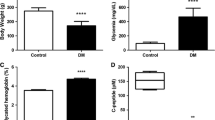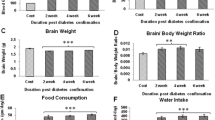Abstract
Diabetes mellitus is characterized by chronic hyperglycemia and its diverse complications. Hyperglycemia is associated with inflammatory responses in different organs and diabetic patients have a higher risk of developing neurodegenerative disorders. Methylglyoxal is a reactive advanced glycation end product precursor that accumulates in diabetic patients. It induces various stress responses in the central nervous system and causes neuronal dysfunction. Astrocytes are actively involved in maintaining neuronal homeostasis and possibly play a role in protecting the brain against neurodegeneration. However it is not clear whether methylglyoxal exerts any adverse effects towards these astrocytes. In the present study we investigated the effects of methylglyoxal in astrocytic cultures and hippocampi of experimental animals. The cells from the astrocytic line DITNC1 were treated with methylglyoxal for 1 to 24 h. For the in vivo model, 3 months old C57BL/6 mice were treated with methylglyoxal solution for 6 weeks by intraperitoneal injection. Following the treatment, both astrocytes and hippocampi were harvested for MTT assay, Western blot and real time PCR analyses. We found that methylglyoxal induced astrogliosis in DITNC1 astrocytic cultures and C57BL/6 mice. Further, activation of the pro-inflammatory JNK signaling pathway and its downstream effectors c-Jun were observed. Furthermore, increased gene expression of pro-inflammatory cytokines and astrocytic markers were observed from real time PCR analyses. In addition, inhibition of JNK activities resulted in down-regulation of TNF-α gene expression in methylglyoxal treated astrocytes. Our results suggest that methylglyoxal may contribute to the progression of diabetes related neurodegeneration through JNK pathway activation in astrocytes and the subsequent neuroinflammatory responses in the central nervous system.





Similar content being viewed by others
Abbreviations
- CNS:
-
Central nervous system
- GFAP:
-
Glial fibrotic acidic protein
- IL:
-
Interleukin
- JNK:
-
c-Jun N-terminal kinases
- ROS:
-
Reactive oxygen species
- RT-PCR:
-
Real time polymerase chain reaction
- TGF-β:
-
Transformation growth factor beta
- TNF-α:
-
Tumor necrosis factor alpha
References
Abordo EA, Minhas HS, Thornalley PJ (1999) Accumulation of alpha-oxoaldehydes during oxidative stress: a role in cytotoxicity. Biochem Pharmacol 58:641–648
Ahmed N, Ahmed U, Thornalley PJ et al (2005) Protein glycation, oxidation and nitration adduct residues and free adducts of cerebrospinal fluid in Alzheimer’s disease and link to cognitive impairment. J Neurochem 92:255–263
Arundine M, Tymianski M (2003) Molecular mechanisms of calcium-dependent neurodegeneration in excitotoxicity. Cell Calcium 34:325–337
Beg AA, Baltimore D (1996) An essential role for NF-kB in preventing TNF-α-induced cell death. Science 274:782–784
Belanger M, Yang J, Petit JM et al (2011) Role of the glyoxalase system in astrocyte-mediated neuroprotection. J Neurosci Off J Soc Neurosci 31:18338–18352. doi:10.1523/JNEUROSCI.1249-11.2011
Bendtzen K (1988) Interleukin 1, interleukin 6 and tumor necrosis factor in infection, inflammation and immunity. Immunol Lett 19:183–192
Butterfield DA, Di Domenico F, Barone E (2014) Elevated risk of type 2 diabetes for development of Alzheimer disease: a key role for oxidative stress in brain. Biochim Biophys Acta 1842:1693–1706. doi:10.1016/j.bbadis.2014.06.010
Chen LW, Yung KL, Chan YS (2005) Reactive astrocytes as potential manipulation targets in novel cell replacement therapy of Parkinson’s disease. Curr Drug Targets 6:821–833
Choi SS, Lee HJ, Lim I et al (2014) Human astrocytes: secretome profiles of cytokines and chemokines. PLoS One 9, e92325
Chu JM, Lee DK, Wong DP et al (2014) Ginsenosides attenuate methylglyoxal-induced impairment of insulin signaling and subsequent apoptosis in primary astrocytes. Neuropharmacology 85:215–223. doi:10.1016/j.neuropharm.2014.05.029
Clarke LE, Barres BA (2013) Emerging roles of astrocytes in neural circuit development. Nat Rev Neurosci 14:311–321
Danbolt NC (2001) Glutamate uptake. Prog Neurobiol 65:1–105
Dantzer R (2001) Cytokine-induced sickness behavior: where do we stand? Brain Behav Immun 15:7–24
Davis RJ (1994) MAPKs: new JNK expands the group. Trends Biochem Sci 19:470–473
de Arriba SG, Stuchbury G, Yarin J et al (2007) Methylglyoxal impairs glucose metabolism and leads to energy depletion in neuronal cells--protection by carbonyl scavengers. Neurobiol Aging 28:1044–1050. doi:10.1016/j.neurobiolaging.2006.05.007
Devinsky O, Vezzani A, Najjar S et al (2013) Glia and epilepsy: excitability and inflammation. Trends Neurosci 36:174–184. doi:10.1016/j.tins.2012.11.008
Essers MA, Weijzen S, de Vries-Smits AM et al (2004) FOXO transcription factor activation by oxidative stress mediated by the small GTPase Ral and JNK. EMBO J 23:4802–4812
Feuerstein G, Liu T, Barone F (1993) Cytokines, inflammation, and brain injury: role of tumor necrosis factor-alpha. Cerebrovasc Brain Metab Rev 6:341–360
Forman MS, Lal D, Zhang B et al (2005) Transgenic mouse model of tau pathology in astrocytes leading to nervous system degeneration. J Neurosci: Off J Soc Neurosci 25:3539–3550. doi:10.1523/JNEUROSCI.0081-05.2005
Heimfarth L, Loureiro SO, Pierozan P et al (2013) Methylglyoxal-induced cytotoxicity in neonatal rat brain: a role for oxidative stress and MAP kinases. Metab Brain Dis 28:429–438. doi:10.1007/s11011-013-9379-1
Hsu WH, Lee BH, Li CH et al (2013) Monascin and AITC attenuate methylglyoxal-induced PPARgamma phosphorylation and degradation through inhibition of the oxidative stress/PKC pathway depending on Nrf2 activation. J Agric Food Chem 61:5996–6006. doi:10.1021/jf401197r
Jagt DLV (2008) Methylglyoxal, diabetes mellitus and diabetic complications. Drug Metabol Drug Interact 23:93–124
Jang C-W, Chen C-H, Chen C-C et al (2002) TGF-β induces apoptosis through Smad-mediated expression of DAP-kinase. Nat Cell Biol 4:51–58
Ji R-R, Suter MR (2007) p38 MAPK, microglial signaling, and neuropathic pain. Mol Pain 3:33
Kalapos MP (1999) Methylglyoxal in living organisms: chemistry, biochemistry, toxicology and biological implications. Toxicol Lett 110:145–175
Kuhla B, LÜTH HJ, Haferburg D et al (2005) Methylglyoxal, glyoxal, and their detoxification in Alzheimer’s disease. Ann N Y Acad Sci 1043:211–216
Lapolla A, Flamini R, Dalla Vedova A et al (2003) Glyoxal and methylglyoxal levels in diabetic patients: quantitative determination by a new GC/MS method. Clin Chem Lab Med 41:1166–1173. doi:10.1515/CCLM.2003.180
Lindsay RM (1979) Adult rat brain astrocytes support survival of both NGF-dependent and NGF-insensitive neurones. Nature 282:80–82
Maragakis NJ, Rothstein JD (2004) Glutamate transporters: animal models to neurologic disease. Neurobiol Dis 15:461–473. doi:10.1016/j.nbd.2003.12.007
Maragakis NJ, Rothstein JD (2006) Mechanisms of Disease: astrocytes in neurodegenerative disease. Nat Clin Pract Neurol 2:679–689. doi:10.1038/ncpneuro0355
Massagué J (2012) TGFβ signalling in context. Nat Rev Mol Cell Biol 13:616–630
Mclellan AC, Thornalley J (1994) Glyoxalase system in clinical diabetes mellitus and correlation with diabetic complications. Clin Sci 87:21–29
Nagai R, Murray DB, Metz TO et al (2012) Chelation: a fundamental mechanism of action of AGE inhibitors, AGE breakers, and other inhibitors of diabetes complications. Diabetes 61:549–559
Niranjan R (2014) The role of inflammatory and oxidative stress mechanisms in the pathogenesis of Parkinson’s disease: focus on astrocytes. Mol Neurobiol 49:28–38
Pekny M, Wilhelmsson U, Pekna M (2014) The dual role of astrocyte activation and reactive gliosis. Neurosci Lett 565:30–38. doi:10.1016/j.neulet.2013.12.071
Rudge JS (1993) Astrocyte-derived neurotrophic factors Murphy S, Astrocytes: Pharmacology and Function 267–294
Sena CM, Matafome P, Crisostomo J et al (2012) Methylglyoxal promotes oxidative stress and endothelial dysfunction. Pharmacol Res: Off J Ital Pharmacol Soc 65:497–506. doi:10.1016/j.phrs.2012.03.004
Sharma MK, Jalewa J, Hölscher C (2014) Neuroprotective and anti-apoptotic effects of liraglutide on SH-SY5Y cells exposed to methylglyoxal stress. J Neurochem 128:459–471
Sofroniew MV (2013) Multiple roles for astrocytes as effectors of cytokines and inflammatory mediators. The Neurosci 1073858413504466
Srikanth V, Westcott B, Forbes J et al (2013) Methylglyoxal, cognitive function and cerebral atrophy in older people. J Gerontol Ser A Biol Med Sci 68:68–73
Strachan MW, Reynolds RM, Marioni RE et al (2011) Cognitive function, dementia and type 2 diabetes mellitus in the elderly Nature reviews. Endocrinology 7:108–114. doi:10.1038/nrendo.2010.228
Thornalley PJ (2008) Protein and nucleotide damage by glyoxal and methylglyoxal in physiological systems-role in ageing and disease. Drug Metabol Drug Interact 23:125–150
Turk Z (2010) Glycotoxines, carbonyl stress and relevance to diabetes and its complications. Physiol Res 59:147–156
Umegaki H (2012) Neurodegeneration in diabetes mellitus. In: Neurodegenerative diseases. Springer, p 258–265
Urano F, Wang X, Bertolotti A et al (2000) Coupling of stress in the ER to activation of JNK protein kinases by transmembrane protein kinase IRE1. Science 287:664–666
Waetzig V, Czeloth K, Hidding U et al (2005) c-Jun N-terminal kinases (JNKs) mediate pro‐inflammatory actions of microglia. GLIA 50:235–246
Wang XJ, Kong KM, Qi WL et al (2005) Interleukin-1 beta induction of neuron apoptosis depends on p38 mitogen-activated protein kinase activity after spinal cord injury. Acta Pharmacol Sin 26:934–942. doi:10.1111/j.1745-7254.2005.00152.x
Wang L-W, Tu Y-F, Huang C-C et al (2012) JNK signaling is the shared pathway linking neuroinflammation, blood–brain barrier disruption, and oligodendroglial apoptosis in the white matter injury of the immature brain. J Neuroinflammation 9:175–191
Wong DP, Chu JM, Hung VK et al (2013) Modulation of endoplasmic reticulum chaperone GRP78 by high glucose in hippocampus of streptozotocin-induced diabetic mice and C6 astrocytic cells. Neurochem Int 63:551–560. doi:10.1016/j.neuint.2013.09.010
Xiao C, Ghosh S (2005) NF-kB, an evolutionarily conserved mediator of immune and inflammatory responses. In: Mechanisms of lymphocyte activation and immune regulation X. Springer, p 41–45
Xu Q, Park Y, Huang X et al (2011) Diabetes and risk of Parkinson’s disease. Diabetes Care 34:910–915. doi:10.2337/dc10-1922
Author information
Authors and Affiliations
Corresponding authors
Ethics declarations
Conflict of interest
The authors have had no financial, personal or other relationships with other people or organizations. This submission contains original work which has not been published previously and it is not under consideration for publication elsewhere.
Additional information
John M. T. Chu and Dicky K. M. Lee share equal contributions in this manuscript.
Rights and permissions
About this article
Cite this article
Chu, J.M.T., Lee, D.K.M., Wong, D.P.K. et al. Methylglyoxal-induced neuroinflammatory response in in vitro astrocytic cultures and hippocampus of experimental animals. Metab Brain Dis 31, 1055–1064 (2016). https://doi.org/10.1007/s11011-016-9849-3
Received:
Accepted:
Published:
Issue Date:
DOI: https://doi.org/10.1007/s11011-016-9849-3




